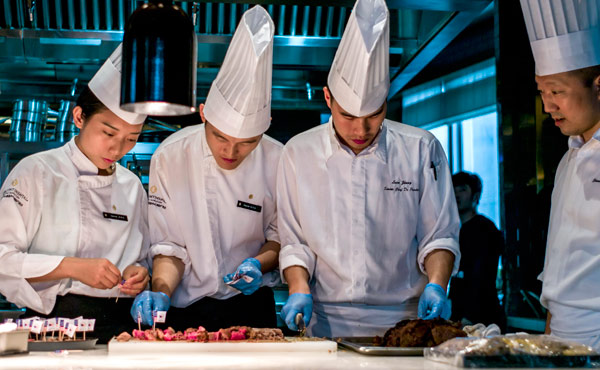US beef proves a big hit with consumers
 |
|
Cooks cut US beef during a promotional event in Beijing over the weekend. [Photo/Agencies] |
The first batch of US beef that re-entered the China market after a 13-year ban has been popular, despite its costly price. The imported US beef, including prime sirloin, filet and rib eye steak, was sold at supermarkets and on e-commerce platforms.
Sam's Club China, a high-end retailer of Wal-Mart Inc, became the first offline retailer to sell fresh US beef. Sam's Club China started to sell US beef at its stores in Beijing on June 27, and it has since run out of stock.
Airlifted to China from ranches in Nebraska, the grain-fed beef was vacuum packed and shipped by cold chain transportation during the whole journey.
Sam's Club China said the second batch of US beef will arrive in China after some time.
In July and August, Sam's Club will start selling US beef at its outlets nationwide, and Wal-Mart Inc did not disclose any specific plans to sell US beef at its supermarkets in China yet.
Chinese online shopping website Tmall.com, which is backed by Alibaba Group Holdings Ltd, has also started to sell US beef. It said 400 grams of fresh sirloin steak sells for 208 yuan ($30.6) on Tmall.com, and 300 grams of filet steak has a price tag of 228 yuan.
In the United States, every hundredweight (45.4 kilograms) of beef is sold for $116 to $126, meaning every kilogram of beef is sold at 17 yuan to 19 yuan, according to a forecast of the US Department of Agriculture.
Since June 20, Chinese authorities started to lift a 13-year ban and allow eligible US beef to be imported into China, according to the statement of the General Administration of Quality Supervision, Inspection and Quarantine of China.
China is currently the fastest-growing market for beef consumption globally, and the imported beef mainly comes from Australia, Argentina, Brazil and Uruguay. China's domestic beef market has a 10 percent demand gap that needs to be fulfilled by imported suppliers.
Michael Finucan, general manager for international markets at Meat and Livestock Australia, said: "Australia competes in many global beef markets with the US. We believe our many years of trading in China have built strong relationships with the industry, and we will be able to continue to have a strong business here."
"Australia is focused on working with our customers to meet their specification requirements. Australia is able to supply a wide range of products that suit many sectors in the market from high-end restaurants and supermarkets to families."

























